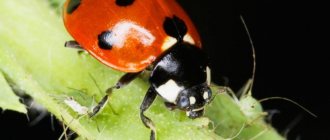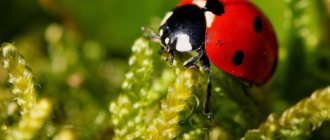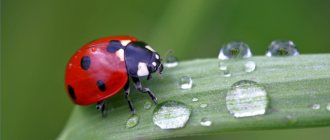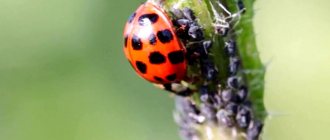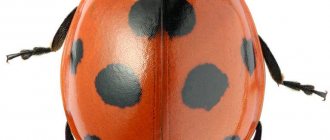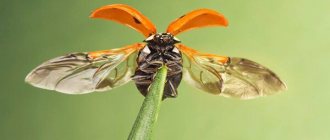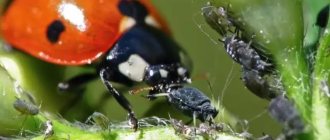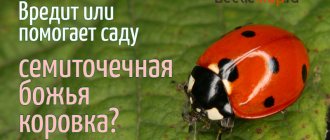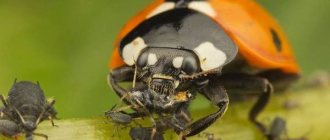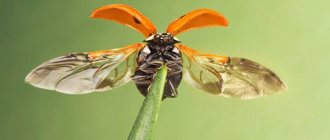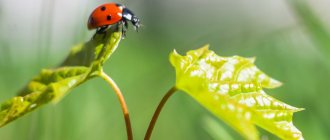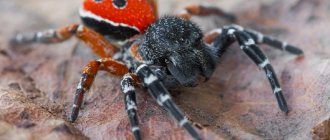Ladybug (lat. Coccinellidae) belongs to the family of beetles, a type of arthropod, a class of insects. When a person sees an insect, he involuntarily has a reaction - to slam it as quickly as possible, but the ladybug evokes sympathy in almost everyone, even women. Some remember a children's song associated with her, others remember that she really helps them out at their summer cottage - saving the garden from pests. What is the secret of everyone's sympathy for this beetle? In some cultures it is forbidden to kill a ladybug, and in the Western part it is generally considered a symbol of good luck. In many countries it is even included in the Red Book. Let's consider the characteristics and lifestyle of this insect, as well as the benefits and harms it can bring.
What does a ladybug look like?
Today, no more than 200 insect formations have been studied on the planet, but the number of species is limitless. The ladybug is a representative of the Coccinellidae family, has over 4000 types and 360 genera, and belongs to the order Coleoptera of the arthropod type. A distinctive feature from other relatives are the seemingly three-part legs. This is due to the small third segment, which is visually hidden with half of the fourth pedicle in the sinus of the bilobed process.
The average size of a ladybug is from 4 mm to 10 mm. The structure of the body is rounded, ovoid, flattened below and convex above. Sometimes the surface is covered with thin fibers.
The head is monolithically connected to the prothorax, everything looks like an enlarged cephalothorax. It makes up the main part of the body length, sometimes found in an elongated oval shape. The eyes are relatively large. The antennae are well flexible and consist of 8-11 segments.
Has rigid expressive elytra. Essentially these are the front flight organs. Over time, the ladybug's wings transformed. On the ground they perform a protective function. With the help of two rear processes, it flies, and it turns out quite well. It is interesting that various birds and many vertebrates do not dare to hunt it not only because of its toxicity. They do not have time to catch it, because the insect makes about 85 strokes per second.
Interesting Facts
Here are some interesting facts about ladybugs:
- In ancient times, people were able to predict the weather with the help of red bugs.
So, if a cow quickly flew away from the palm, this foreshadowed bright and sunny weather in the future. If, on the contrary, the insect did not fly away anywhere and continued to sit on the hand, rain and thunderstorms were expected.
- In many countries, ladybugs are considered a symbol of good luck, so they should never be harmed. Otherwise, you can bring trouble on yourself and your family.
- Scientists still cannot solve the mystery of how ladybugs return each time after migrating to the same places where they lived in the warm season.
- At the beginning of the 19th century, in many European countries and the United States, specially trained people tracked the wintering sites of ladybugs and collected them in bags. In the spring, insects were released into the fields.
In this video, interesting facts about ladybugs will be presented in a fascinating and knowledgeable way, which may surprise someone and help to better “understand” these little red bugs.
Why is the ladybug called that?
Where did the ladybug get its name? The question remains open to this day. Scientific terminology is Coccinellidae, the word itself comes from the Latin meaning “scarlet”. Many ethnic groups have their own versions of names, for example:
- among the Germanic peoples - “the bug of the Virgin Mary”;
- among the Anglo-Saxons - “Lady bird”;
- among the Slavic - “Sun”;
- among Latin Americans - “St. Anthony’s cow”;
- among Asians it is “red-bearded grandfather”.
There are long-standing legends about why the ladybug is called that, let's look at some of them.
She was personified with the heavenly herd of Perun, connected the omnipotent gods and mortal people, and was credited with magical abilities to influence the weather. The Catholic faith considered her a messenger of the Mother of God. The British also associate their names with the Virgin Mary.
The ancient Slavs considered her the messenger of the sun. It was impossible to drive away the heavenly creature, so as not to turn away fortune. A beetle that flew into a home was considered to bring peace and grace, so they called it that way - “Sun”. The very word “God’s” symbolized among the Russian ethnic group a trusting believer. The beetle was compared to a harmless creature.
But more likely the word “lady” is associated with a physiological feature of the insect. It secretes milk, but it is far from usual - a red aggressive liquid formed in the spores of the limbs. The discharge is extremely unpleasant and in large quantities is deadly for those who decide to eat it. And another similarity with a cow is the presence of spots on the body.
Types of ladybugs
The ladybug is not necessarily red, but its coloring is in the form of dots. The dots may be absent altogether, and instead of them, stripes, patterned spots, or comma-shaped spots may appear on the shell. The most common type is the seven-spotted beetle. It lives almost throughout Europe, its dimensions reach 7 mm, the elytra are burgundy, there are two light-colored spots at the base, one dark one can be seen on the pronotum, with speckles on the elytra.
They are also divided according to the number of dots and color:
- two-spotted, usually 5mm dark scarlet individuals with 2 large black markings;
- twelve-pointed up to 6 mm, have pinkish elytra, on which 6 pieces are observed;
- thirteen-spotted up to 7mm, with brownish wings;
- fourteen-spotted - with a yellow color and black spots on them or vice versa;
- seventeen-point identical colors ranging from 2.5 to 3.5 mm;
- variable, with a black pre-back with 2 brownish spots, contrasting markings at the base of the yellowish-red elytra;
- blue ones are found on the Australian mainland and have a beautiful tint of blue and green tones;
- white or light gray - up to 15 marks, less common, like brown plain ones.
Varieties, their names, descriptions and photos
Below is a description of what ladybugs are, a detailed description of the most interesting varieties; You will also be able to see their photos, including close-up photos.
Point-to-point
The body length of the two-spot ladybug reaches about 5 mm. The color is dark red with two parallel black dots on the back (hence the characteristic name). The body has an oblong-oval, moderately convex shape.
The head of light-colored individuals is black, with two large irregularly shaped spots (near the eyes). Dark bugs have a completely black head.
Seven-point
The seven-spotted ladybird is one of the most common species in Europe . The body size is about 8 mm. The color is red, and there are 3 black spots on the sides. The seventh spot is located near the head.
Twelve-point
The twelve-spotted ladybird reaches 6 mm in length. It has a red or pink color. There are 6 black dots on each elytra. The insect lives primarily in North America and feeds on pollen from agricultural plants.
Thirteen-point
The thirteen-spotted ladybird has 13 spots on its surface. Color - red-brown or brick. In this case, some spots may merge with each other. The insect is common in Europe, Asia and North America.
Asian
The Asian ladybird or Harlequin reaches a length of 7 mm. It is either yellow-black or black-orange in color . The insect lives in Asia and feeds on aphids.
Note! This species is characterized by the greatest gluttony, therefore it is specially cultivated in Europe and North America to combat agricultural pests.
Ocellated
The ocellated ladybug is considered one of the largest and reaches a length of approximately 1 cm. The color is red or yellow. In this case, each of the spots is surrounded by a lighter halo. There are 20 such “eyes” on the back of the insect.
Pointless
The spotless ladybird is one of the rarest species , characterized by a complete absence of dark spots. The body of the insect is red or brown in color and covered with barely noticeable fibers. The insect reaches several millimeters in length.
Blue
The blue cow is the most unusual representative of this family. A distinctive feature of the insect is the blue color of the elytra with a characteristic metallic sheen. Dark spots on the back are absent (or simply not visible, because they merge with the dark blue color).
It lives in the eastern part of Australia, as well as in New Zealand. The insect feeds mainly on aphids. The body size does not exceed 4 mm.
Bright warning coloration of a ladybug
The ladybug is endowed with bright colors, which help in the struggle for existence and strike fear into enemies, most often birds. This is one example of mimicry, like the green color of grasshoppers, or the ability of a chameleon to blend into its environment for the purpose of self-preservation.
The striking colors of the natural wild world serve as warning signals about the toxicity and inedibility of the observed prey. There is a theory that the brighter the color of the beetle, the less likely it is to be attacked by enemies. The expressive color of various types of ladybug indicates mortal danger. It may fade with age.
Habitats
Ladybugs live over a wide geographical range, on almost all earthly surfaces.
continents with the exception of Antarctica and the polar Arctic regions. As for habitats, some of them prefer to live on plants where a colony of aphids has formed, others choose sedge and reeds along water bodies as a home, while others live in field grasses.
Where do ladybugs live?
Ladybugs live almost all over the world, except in northern latitudes. Their life cycle depends on the availability of food. The active stage occurs during the extermination of aphids, the main diet of these insects, i.e. from spring to autumn. They live from a couple of months to one year, and occasionally last up to two. Able to survive winter in foliage or under the bark of trees.
A solitary lifestyle is acceptable to them; they settle in groups for wintering or for mating. They feel comfortable in open areas with grassy vegetation on forest edges, steppes, meadows and gardens.
In search of food, they crawl through plants, periodically flying over long distances. They do this easily, silently, working all day, destroying pests. Cows are thermophilic, the optimal temperature for them is +10 C and above; during other periods they spend the winter.
Pests
Aphid (lat. Aphidoidea) is a small, sedentary insect, no more than 8 mm in length.
The only food for them is plant sap, which aphids extract by piercing a leaf or stem with their sharp proboscis and sucking it out. Many of them excrete sweet excrement or honeydew when feeding, because... They cannot digest sugar, which attracts ants.
They mainly live in dense, huge colonies, which are most often found in countries with tropical and mild climates. Aphids have learned to overwinter by laying their eggs in cracks in the bark, near the buds and in other secluded places. In each colony there are winged and wingless individuals, each of them plays its own role.
In the spring, wingless females emerge from the eggs and are able to reproduce without fertilization. These females immediately give birth to live larvae. And only by mid-summer do winged females appear. The lifespan of one generation is usually 10 days. Aphids can sit on one plant all their lives and feed on it due to their inactivity, until it finally dies. Their enemies are ladybugs.
How and where do ladybugs overwinter?
When cold weather sets in, sedentary varieties of ladybirds gather in large groups, sometimes up to millions of individuals. In winter, they look for secluded places, hiding under the remains of falling leaves, dry wood, stones, where they wait for the arrival of warmth. They can fly indoors, hide between window frames, folds of curtains, and arrange nesting sites among trees.
There are species of beetles that fly away in flocks to winter in southern latitudes. Recently, features of adaptation to the environment have become not only bright colors or toxic liquid released when dangerous. Their group aggregations are becoming more and more observed. This is still inexplicable, but the spectacle is colorful.
If you find a “sleepy colony” of cows, do not disturb them and bring them home to warm them up. Think about how many pests they will be able to kill in the future. Move them to a comfortable place where no one will crush them, let them calmly complete their hibernation.
What do ladybugs eat? Are they predators?
A characteristic feature of insects of the order Coleoptera is the gnawing type of mouthparts. The ladybug has similar anatomical characteristics. The structure of the digestive system begins with the mouth and ends on the abdomen with the anus. The intestinal canal runs between them. This allows the insect to consume complex molecular food with a high energy reserve when feeding.
Simply put, the coccinellid is a predator; it eats its own kind. Diet preferences are given to:
- aphids;
- spider mites;
- small caterpillars;
- eggs of butterflies, Colorado beetles;
- larvae of insect pests.
There is also a species that feeds on plant foods: pollen, flowers and leaves, mycelium, and fruits.
Stethorus
Stetorus is the closest “relative” of the ladybug: both beetles belong to the same family. However, in appearance they bear little resemblance.
Stetorus is a small bug (its maximum length is only 1.6 mm) and black. However, despite its tiny size, it copes with the destruction of pests “excellently”. Stetorus uses spider mites as food. During its existence, the bug eats at least 2000 ticks. For this reason, Stetorus is also called the tick ladybird.
Stetorus larva. Photo from scontent.ces.ncsu.edu
Before using chemicals to control spider mites, carefully inspect the plant. Perhaps tiny stetorus beetles are already operating there and they will cope with ticks without any “chemistry”.
Reproduction of ladybugs
Ladybugs reproduce several times a year, in spring or autumn. In temperate latitudes this is the beginning of May. The female becomes sexually mature at the age of 3-6 months. As a rule, after a cold period, she is able to emit a pungent odor that attracts males.
The female places eggs on vegetation with an abundance of aphids, providing food for future offspring in advance. They have an elongated shape, narrowed towards the end, and are colored yellowish-orange. One clutch can number from several to 400 pieces, arranged in even rows, close to each other. Sometimes they can be eaten by their own relatives, the so-called cannibal larvae.
Ladybug larvae - what do they look like?
Further development occurs over 4-7 days and has several stages. The larvae are oval in appearance. They look colorful due to yellow-orange spots that form a certain pattern. Body surface with bristles, peculiar outgrowths. Newborn ladybugs that feed on scale insects are covered with whitish, waxy threads. Everything grows in 2-4 weeks.
After this stage comes the moment of pupation. To move into it, the individual attaches the back of the body to the leaf plate and curls into a semi-bent position. At the end of the internal transformation, the skin peels off the pupa, sliding like a stocking to the end of the abdomen. It does not lose its bright color with black and yellow specks. Next, from 7 to 10 days, an adult is formed.
The benefits and harms of ladybug
The boundless gluttony of this predatory beetle brings great benefits to homesteads and agricultural crops, because it eats aphids that harm the crop. While in the larval stage, the coccinellid consumes up to 50 prey per day. An adult insect eats up to 100 aphids. They help plants by clearing crops of pests. Therefore, they are even bred at specialized enterprises, and then distributed over the fields with the help of aviation.
But harm can be caused by herbivorous species of these beetles; their habitats are in Asia. There they cause significant damage to crops. In our area, some harm vegetables: potatoes, sugar beets, tomatoes and cucumbers.
Security
The ladybug is already listed in the Red Book in many countries, including Russia.
If this insect completely disappears, humanity will face an imbalance in nature and the active proliferation of dangerous pests, which will have to be destroyed chemically.
Therefore, today ladybugs are successfully bred in laboratory conditions , and then released into the fields. But in order to maintain balance, it is necessary to abandon the chemical destruction of aphids and direct general efforts to improve the ecological situation of the environment.
Ladybugs are amazing creatures of nature that bring great benefits to people (with the exception of herbivorous species). They protect crops from various kinds of parasites, thereby preserving the harvest and allowing humanity to do without chemicals. However, in recent years the number of these beneficial insects has noticeably decreased, so they are listed in the Red Book and attempts are being made to restore the population artificially.
